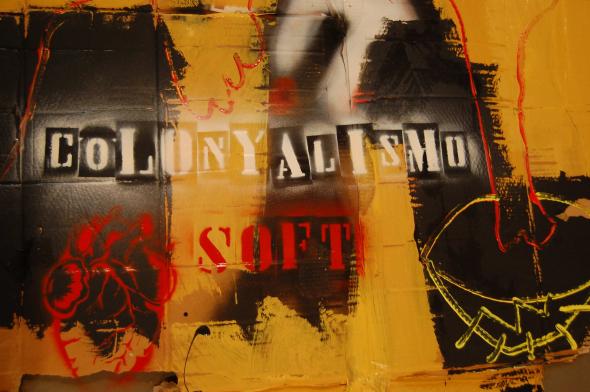Making cultural inheritance the theme for contemporary artistic creation
ROOTS is the most recent artistic residency project organised by LAC - Laboratory of Creative Activities a cultural association based in Lagos, founded in 1995 and which congregates activists from different cultural and artistic areas. LAC promotes artistic residencies making the most of the spatial circumstances of the place in which they are established the building of the old municipal jail. The peculiar “spirit of the place” enables the development of creativity, crossing experiences and artistic trajectories of a wide diversity. It is that environment that has, paradoxically contributed to transform that which was formerly a place for the deprivation of freedom into an incubator for the affirmation of creative autonomy intersecting visual and performative arts and new communication technologies that has asserted Lac as one of the most interesting incubators for artistic creativity in the Algarve.
The ROOTS project approaches the slavery theme through/from a contemporary vision inspired by an archeological discovery in 2008 in the “green circle” in Lagos at the location which was known as the “Vale da Gafaria” (Valley of the Leper Hospital). In the area rescue archeological excavations that preceded the construction of one of the city’s underground car parks enabled the methodological investigation of the whole area affected by the enterprise - one of the ex-libris of urban regeneration that the municipal administration was able to carry out in the decade of the XXI Century.
The archeological work confirmed the presence at the site of the ruins, already of an old city leper hospital, conveniently situated outside the perimeter of the old medieval city walls and that was maintained further outside this structure with the construction of the Sixteenth century New Wall. The leper hospital had already been refered to in the oldest know town map datting back to the XVI century and that by circumstance of the Hispanic Monarchy of the Filipes, is presently conserved in the Military Archives of Stockholm in Sweden. However, the most surprising discovery during these campaigns of arqueological excavations was the presence of an impressive heap of rubbish that had accumulated between the XV and XVII Centuries outside the walls of the old city, true capital of the Discoveries at the dawn of
The modern era. For more than two centuries between the period when Infante Dom Henrique was donatory of the town of Lagos and the declining capitalness of the city of Lagos as residence of Algarve´s Military Governors, this vast rubbish dump collected the mortal remains of black African slaves, more than a hundred and fifty that once dead were hurl into this place.
 obra de Abraão Vicente
obra de Abraão Vicente
Already the “Crónicas da Conquista de Guiné” (chronicles of Guiné´s conquest) by Gomes Eanes de Zurara, in particular the remarkable description of the selling of 235 black captives brought by Lançarote de Freitas which occurred in Lagos in 1444 under the direct command of the Infante, was a sure indicator of the central role played by the city in the slave trade routes. As well as this the historic building of the old customhouse known as the “Slave Market”, placed Lagos in a privelaged position for evoking the memory of slave trafficking in Portugal and the world. Nevertheless the archeological discovery of the old rubbish dump in the “green circle” and the bioanthropological characterisation of the human remains retrieved from that place came to offer direct material evidence of one of the most sombre facets of the history of the Discoveries´city, about which there is practically no textual witness.
Reclaming that memory of slavery, the project organised by LAC, joined simultaneously with two strategic lines of orientation put forward for the development of the Algarve on the cultural plane: on the one hand for the increase in value of the region´s Cultural Patrimony, creating bridges between the historical inheritance and contemporary cultural creation, potentializing new social and creative dynamics; on the other hand for the internationalisation of endogamous creative potential, reinforcing the chain of relationships that stimulate artistic work and may contribute to the international assertion of the Algarve within the domain of the Economy of Creativity.
It was timely the invitation extended to five artists protagonists of the ROOTS residency to develop a creative project of great cultural diversity and global and plural miscegenation. The artistic residency happened in an environment where common roots were identified, between creator that, in their condition as “the dislocated”, reflected over their own identity, in a process of symbiosis with the historical and local trajectory. This double notion of trajectory – personal (physical) and local (historic) - was also the undertone of Roots Connection, part of a complementary programme due to Jorge Rocha´s initiative on of the dynamic “carers” of the ROOTS project in which I had the pleasure to participate along with other guests – historians, cultural managers, artists -, whose presence, in some cases virtual, enabled conversation that revolved around the arquelogical discovery of the “green circle” and projects that stimulate exchanges encompassing collaborative processes of production within the domain of the Economy of Creativity.
The ROOTS project is an example of what is possible and necessary: that there be a multiplication in the region of this kind of initiatives, of contemporary artistic creation, promoted by entities that, although receiving little, have been able to occupy space as a public service and that the State has, until now, been incapable of structuring conveniently. Making the most of the “spirit of a place” that allows for the assertion of creative environments, LAC has shown its worth in this indispensable intersection of experiences and artistic trajectories, of the most diversified, with multiple areas of knowledge production – in environments where the creative process, with the sharing of ideas and live experiences, not only makes sense of the material side that reminisces but that constitutes, after all, its essence.